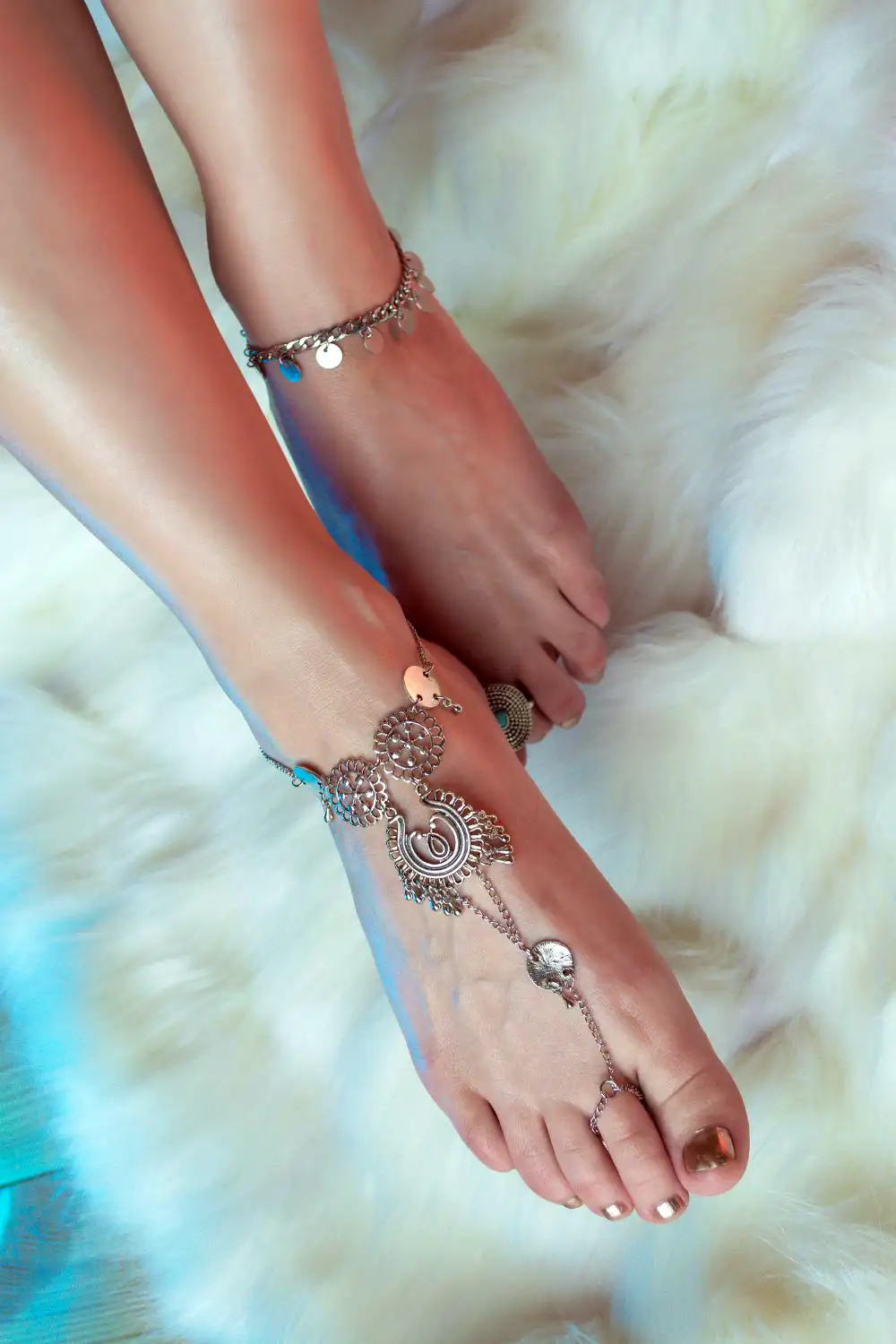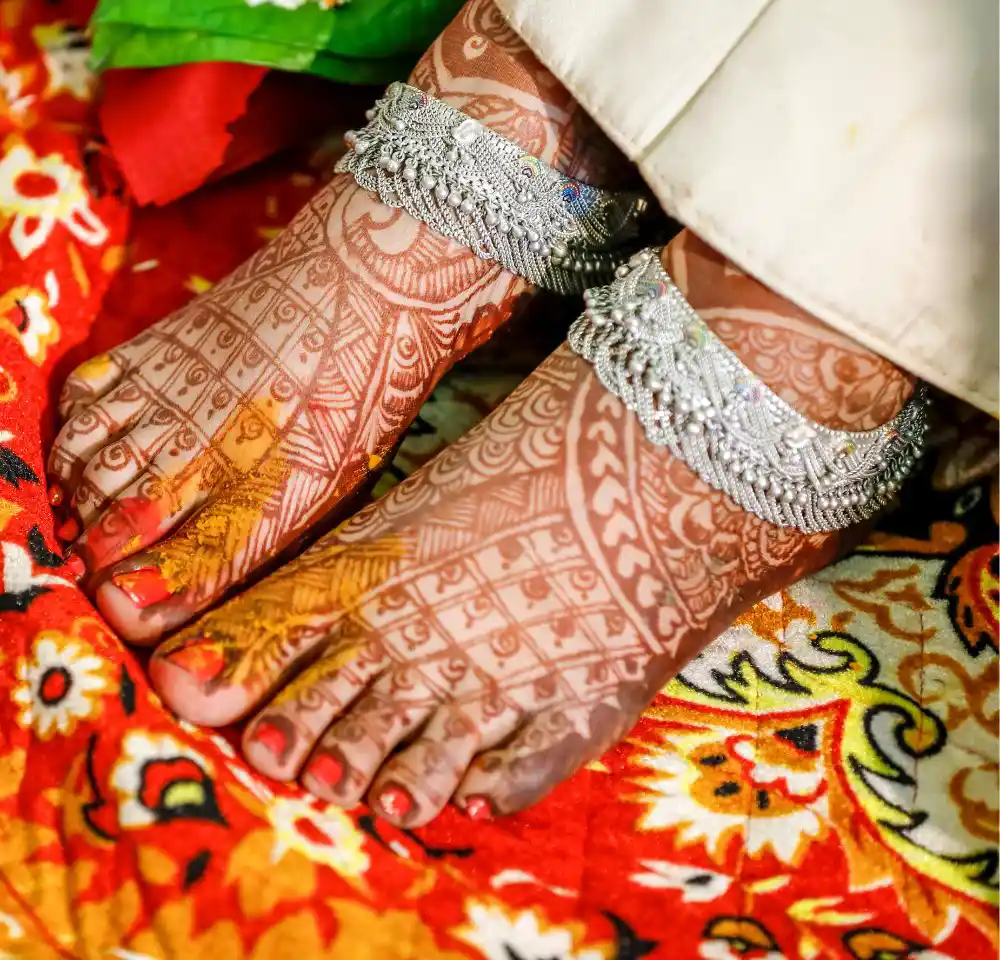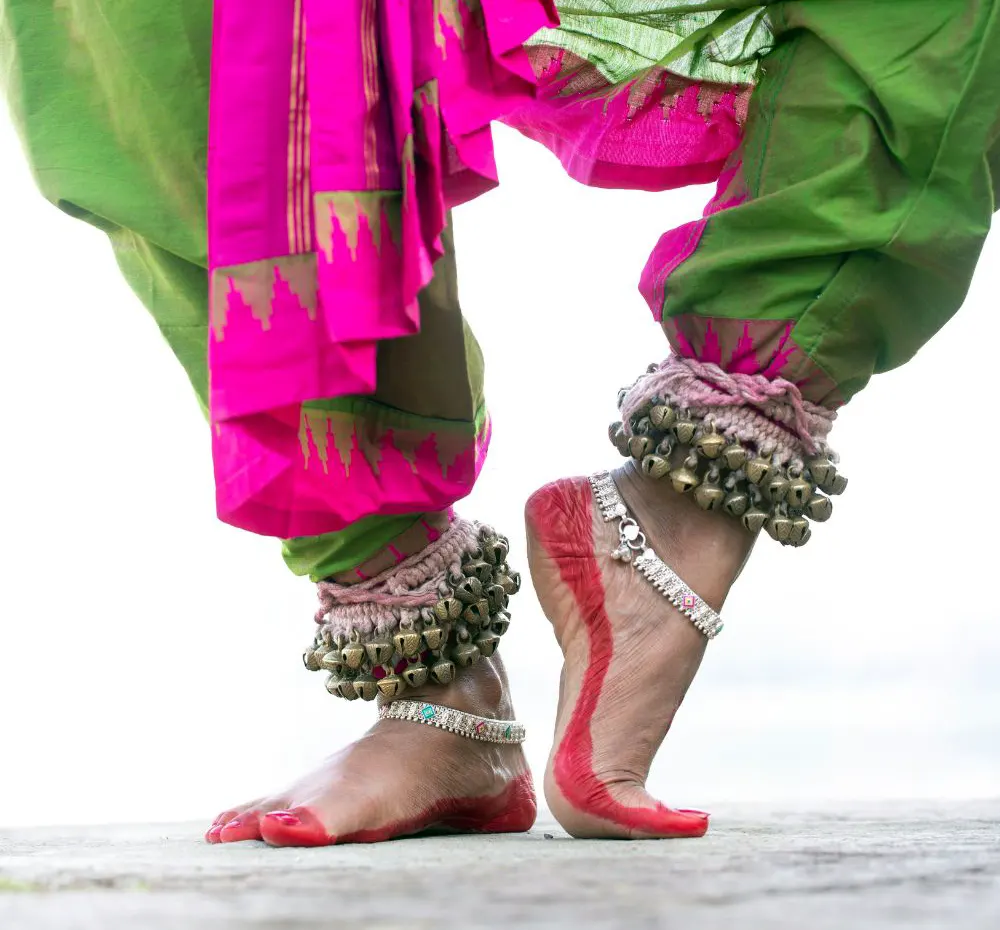Anklets, also known as payal, play an important role in Indian women’s lives. Indian ladies wear anklets for various reasons, from cultural traditions to religious beliefs and even health benefits.
Anklets have been integral to Indian women’s ornamentation for centuries, adding beauty and symbolizing femininity, pride, and cultural identity. They connect to the ways of life and belief systems of past generations of Indian women.
The elaborateness of an Indian woman’s anklets can indicate her social status based on cultural norms related to wealth and marital status. The melodious sound of jingling anklets is considered auspicious and a mark of an elegantly adorned woman.
Overall, anklets symbolize cultural concepts of traditional Indian beauty that women strive to embody and pass on to the next generations. Anklets in India have significance beyond just fashion accessories; they represent a woman’s cultural roots, social status, and adherence to tradition.
Let’s get in deeply into the reasons for Indian women wearing anklets.
Why do Indian ladies wear anklets?
As a cultural symbol of beauty and tradition
Indian women wear anklets as a symbol of cultural beauty and tradition that has been passed down through generations. Anklets have been integral to Indian women’s ornamentation for centuries, representing femininity, pride, and cultural identity.
Women wear anklets to demonstrate their roots in Indian culture and heritage. Anklets have been part of Indian tradition since ancient times, worn by women of all social statuses as an auspicious ornament. They connect to the ways of life and belief systems of past generations of Indian women.
The type of anklets Indian women wear also indicates their societal position based on cultural norms. In the past, married women would wear more elaborate anklets than unmarried women to signify their marital status.
Even today, wealthy women often wear expensive gold anklets, while women of lesser means opt for cheaper materials like beads.
The aesthetic appeal and sound of jingling anklets also tie them to notions of cultural beauty. Anklets highlight and enhance the natural beauty of women’s feet and ankles according to Indian standards of feminine ideal.
The tinkling sound of ankle bells is considered melodious and auspicious, a mark of an elegantly adorned Indian woman.
In summary, anklets symbolize cultural concepts of beauty, femininity, and tradition that Indian women strive to embody and pass on. Anklets represent pride in Indian womanhood and cultural identity, linking to past generations’ traditions and lifestyles.
Anklets indicate a woman’s societal position based on cultural norms related to marital status and wealth. The aesthetic appeal and melodious sound of jingling anklets tie them to notions of Indian cultural beauty.
Overall, anklets have significant cultural value as a symbol of tradition that showcases the cultural identity of Indian women.

For religious protection and good luck
Indian women wear anklets mainly for religious protection and to invoke blessings. Anklets are deeply associated with the goddess Lakshmi, who represents wealth and fortune.
Wearing anklets dedicated to Lakshmi is believed to please the goddess and attract her blessings of prosperity and good health. Many Lakshmi anklets are made with gold coins etched with Lakshmi’s image, which are thought to carry her divine energies.
Anklets in Hinduism are viewed as sacred ornaments that offer spiritual protection from negative energies. Their status as sacred jewelry made from gold and silver imbues them with the power to shield the wearer.
Many Indian women wear an anklet jewelry set comprising a toe ring and the anklet, deemed powerful in deflecting evil. The sound produced by the ankle bells is Auspicious, resonating positive energy that keeps spirits at bay.
Anklets also serve as outward symbols of marital status for Indian wives. Married women are encouraged to wear them to seek marital bliss and protection for their families.
They indicate to the world that the woman belongs to her husband, and the husband takes pride in his wife publicly displaying her marital status through anklets.
Anklets bestowed on a woman by her husband on special occasions like marriage anniversaries are considered particularly sacred and lucky.
Overall, religious significance on multiple levels drives most Indian women’s preference for anklets rather than just aesthetic appeal.
Their associations with the goddess Lakshmi, status as sacred ornaments, marital symbolism, and ability to generate auspicious sounds imbibe anklets with spiritual powers that Indian wives seek for blessings of prosperity, protection, and happiness.
To accentuates ankle and leg for aesthetic appeal
Indian women wear anklets mainly for their aesthetic appeal, as they enhance the look of the ankle and leg.
Anklets add an element of grace, elegance, and femininity to a woman’s feet, making them appear more slender and elongated. Whether with traditional Indian wear or modern outfits, anklets complement a woman’s overall appearance in a delicate yet eye-catching manner.
The wider variety of styles available allows women to choose anklets that suit their fashion sense and personality.
Simple silver chain anklets create an understated elegance, while ornate ones embellished with stones accentuate the wearer’s flamboyant side. Gold anklets symbolize luxury and higher social status. Beaded anklets exude vibrancy and youthfulness.
The jingle of belled anklets while walking draws attention to the wearer’s feet in a subtle yet attention-grabbing way. The sound is reminiscent of Indian culture and is believed to signify fertility.
Anklets accentuate ankle contours and curves, making the lower leg appear slimmer. They beautify the lotus-like shape of a woman’s feet, elevating them into objects of artistic grace.
A well-adorned ankle can transform an otherwise ordinary outfit. Anklets complement saris, salwar kameez, and leggings equally well, making them versatile accessories for all occasions.
While anklets remain a compulsory part of bridal jewelry for their bride-beautifying properties, unmarried women also wear them as fashion statements aligned with trends.
Overall, Indian women wear anklets predominantly to enhance the aesthetic appeal of their feet and lower limbs. It beautifies the ankles in myriad ways, making them appear slimmer, elongated, and more graceful.
Anklets allow women to express their unique sense of style while celebrating Indian cultural traditions at the same time. They add glamour and sophistication to a woman’s look in an understated yet eye-catching manner.
As a symbol of fertility and prosperity
Indian women wear anklets primarily as a symbol of fertility, prosperity, and good fortune. The tinkling sound produced by moving anklets is regarded as auspicious and believed to attract positive energy and blessings.
Anklets signify that the wearer will be blessed with children and prosperity. Married women wearing anklets is considered an indication of a thriving marriage.
Anklets are viewed as warding off evil spirits and bad luck in Indian culture. Their tinkling sounds are seen as a way to keep evil at bay.
Women wear anklets during important Hindu religious ceremonies and festivals as they are thought to bestow blessings of abundance and health. Women wearing gold or silver anklets signify affluence and social status within their community.
There are various types of anklets worn for different purposes. Married women wear intricately designed gold or silver jhumkas signifying their marital status and auspicious nature.
Women wear seasonal ankle chains made of inexpensive materials during spring festivals celebrating new beginnings and good fortune. Gold coins are attached to anklets dedicated to the goddess of prosperity, symbolizing the desire for wealth.
The most popular design remains the dainty chain or spiral band anklet, which completes any traditional outfit.
The jingling sound of the ankle bells draws attention to the wearer’s feet and ankles in an elegant manner. The gentle chime signifies to onlookers that Lakshmi, the fertility goddess, will bless the wearer.
Subtle ankle adornment has long been synonymous with Indian culture and the prosperity it brings. Anklets help women connect to their traditions while adding grace to their overall appearance with minimum fuss.
Ultimately, Indian women wear anklets primarily to symbolize auspiciousness and good fortune. Anklets signify that the wearer will receive blessings of fertility, prosperity, good health, and abundant resources. Their tinkling sounds are believed to attract positive energy and ward off evil spirits.

For health benefits, improved circulation and cramp relief
Indian women wear anklets for aesthetic, cultural, and religious reasons and potential health benefits.
Anklets are believed to improve blood circulation in the legs and ankles, reducing swelling, aching, and fatigue in the feet. The constant friction created between the anklet and skin stimulates blood flow, helping carry nutrients and oxygen to tissues while removing waste products. This also helps keep varicose veins and other circulation issues at bay.
The pressure applied by anklets on specific acupuncture points in the ankles is thought to relieve joint pain and body aches, especially lower back pain and menstrual cramps.
Silver anklets are believed to have natural antibacterial properties that inhibit the growth of bacteria and fungi, promoting the healing of wounds and cracked heels. Silver ions released from the anklet can allegedly kill common pathogens.
Anklets containing coins inscribed with Hindu deities like Lakshmi are believed to boost immune strength by activating the lymph glands near the ankles.
Lakshmi anklets, in particular, are thought to curb stress and anxiety through their sonic vibrations and tinkling sounds that soothe the mind. The delicate sound of ankle bells is calming and pleasing to the ears, inducing feelings of tranquility and well-being.
Despite the lack of clinical trials to fully validate these claims, many Indian women swear by the health benefits of wearing anklets regularly, especially medicinal gold and silver varieties.
Anklets with beads made from Rudraksha seeds, Tulsi wood, and other Ayurvedic materials are also thought to bestow manifold healing powers. However, most women cite aesthetics and social influences as their primary reason for wearing anklets rather than health alone.
In summary, Indian women wear anklets not just for cultural and aesthetic reasons but also to reap potential health benefits like improved circulation, reduced swelling, and pain relief.
Various metals, designs, and materials used in making anklets are believed to activate lymphatic drainage, improve immunity, curb anxiety, and induce feelings of tranquility through sonic effects.
However, solid clinical evidence to validate most health claims about wearing anklets is still lacking.
As a sign of marital status marker for fidelity
Indian married women often wear anklets as a symbol of their marital status. Certain types of ornate anklets signify to onlookers that the wearer is married, with different designs indicating social standing and wealth.
An intricate silver or gold anklet bedecked with stones traditionally serves as a visual badge of honor for an Indian wife, proclaiming her commitment to her husband and family.
In ancient India, married women would wear distinctive ankle bracelets adorned with bells and charms to signify their marital status and command respect from others.
The tradition of using anklets as a marker of a woman’s role as a married woman and wife has persisted over time. Anklets worn by married women tend to be fancier and heavier than those worn by unmarried women to denote the wearer’s status visually.
An unmarried Indian woman wearing anklet risks being seen as overly forward or ostentatious, as anklets traditionally represent the attachment and fidelity of an Indian wife to her husband.
However, many young, unmarried Indian women now wear anklets as fashion statements rather than marital markers. Still, elaborate gold and silver adornments that jingle remain largely the domain of married Indian women seeking to advertise their roles as wives.
The sound of an Indian married woman’s anklets evokes positive associations of marital bliss and domestic prosperity within Indian culture.
An Indian husband takes pride when his wife publicly displays her marital status through anklets as it reaffirms his role as a provider and signals the prosperity and happiness of his household.
Overall, Indian married women typically wear anklets to symbolize their marital status and fidelity to their husbands. Elaborate gold and silver anklets embellished with precious stones signal the wearer’s wealth and commitment to family.
The tradition of using anklets as a marital status symbol derives from ancient Indian culture but persists today, though many unmarried Indian women also wear anklets as trendy accessories.

As a social status indicator and wealth representation
Indian women’s choice of anklets often reveals their social status and economic means within the community.
Their anklets’ intricacy, materials, and design act as silent indicators of wealth and standing to onlookers. Gold and silver anklets usually signify higher status, while beads and shells denote lower status.
Wealthier women wear ankle chains made of precious metals like 22-karat gold embedded with expensive gemstones like diamonds and emeralds that are beyond the reach of common folks.
The finer details and higher craftsmanship that go into making such anklets communicate the owner’s elevated social position. Even the weight and jingle of gold or silver anklets differ noticeably from cheaper imitations.
Anklets incorporating coins engraved with images of Hindu gods coveted for their supposed ability to fulfill wishes generate admiration as signs of financial affluence needed to acquire them.
Their prominence reveals that the wearer belongs to an elite group that has ample resources at its disposal. The louder the jingling of anklet bells, the higher the social status implied.
In contrast, lower income groups depend on clay, synthetic beads, or seashell anklets that simultaneously satisfy the aesthetic urge for ornamentation and remain within their price range. These anklets lack the opulence associated with precious metals and stones, downplaying the wearer’s social rank.
Anklets made from cowrie shells were once affordable to all but now denote backwardness or poverty due to the easy availability of cheaper alternatives. Antique shell anklets handed down for generations now ironically represent the prestige and high status of their original owners.
In summary, different materials, designs, and craftsmanship that go into Indian women’s anklets communicate their relative social status and economic means within the community. The intrinsically “louder” and more opulent the anklets, the higher the implied rank of the wearer.
As the spiritual symbol of prosperity and elegance
Indian women wear anklets mainly for their spiritual significance, as anklets are believed to symbolize prosperity, elegance, and good fortune. Anklets are considered sacred ornaments in Hinduism that bring blessings and positive energy to the wearer.
In Indian culture, anklets are closely associated with the goddess Lakshmi, representing wealth and prosperity. Wearing Lakshmi anklets is thought to please the goddess and attract her blessings.
Lakshmi anklets are commonly made with gold coins engraved with Lakshmi’s image, which are believed to carry her divine energies. Women wear such anklets to seek the goddess’ blessings for prosperity and good health.
The sound of anklets jingling as a woman walks is considered auspicious in Indian culture, as it is believed to ward off evil spirits and bad luck. The tinkling sound of ankle bells is seen as a way to keep negative energies at bay.
Women often wear anklets during important Hindu ceremonies and festivals as they are thought to bestow blessings of abundance and wealth.
Anklets are viewed as sacred jewelry that stimulates certain energy points in the feet, bringing balance and grounding to the wearer. They symbolize women’s prosperity, confidence, and bravery, with more intricate anklet designs denoting higher social status.
Anklets accentuate the wearer’s grace and elegance through their beauty and spiritual symbolism.
In summary, anklets have immense spiritual significance for Indian women, as they are believed to symbolize prosperity, good health, and elegance.
Anklets are considered sacred ornaments that bring blessings when worn. They are closely associated with the goddess Lakshmi and seek her favors for prosperity.
The tinkling of anklets is seen as an auspicious way to ward off evil. Anklets stimulate energy points in the feet, bringing balance while reflecting the wearer’s social status and confidence through their design.
Its distinct noise announces the arrival and draws attention
Indian women wear anklets with bell ends that jingle distinctly as they walk primarily because the sound is considered attractive and attention-grabbing. The soft chime emanating from a woman’s ankles enhances her presence, draws the eye toward her feet, and adds to her overall appeal.
In Indian tradition, the tinkling sound of ankle bells is regarded as feminine and delicate. The chime is melodious yet subtle, announcing the wearer’s arrival without being overpowering.
The bell tones drifting through the air alert others to the woman’s presence in an aesthetically pleasing way. As she moves, the variation in pitch and cadence of the chimes follows the grace of her steps, complementing her poise and elegance.
Anklets with bells are an effective nonverbal means for women to attract attention. The delicate jingle draws onlookers’ gazes downward, emphasizing the aesthetic lines of the wearer’s feet and ankles.
Framed by the sound of bells, a woman’s feet become objects of visual interest and admiration, subtly enhancing her charm.
Belled anklets represent an intermediate form of communication for Indian women — neither fully public nor entirely private.
The chimes act as an audible signature announcing a woman’s movements while leaving the choice to engage visually up to the listener. This allows women greater control over social interactions without resorting to overt verbal cues.
In summary, Indian women wear anklet bells primarily for their attractive and attention-grabbing nature. The soft chime emanating from a woman’s ankles enhances her presence, draws the eye toward her feet, and adds to her overall appeal.
Belled anklets are an aesthetically pleasing yet subtle way to announce a woman’s arrival and attract attention. The chime compliments her graceful movements while the sound frames her feet, enhancing their visual appeal and subtly augmenting her charm.
As fashion jewelry and an expression of personal style
Indian women wear anklets as a fashion statement to reflect their personal style and complement their overall look.
Anklets come in various styles and designs, allowing women to choose pieces that suit their individual tastes and aesthetics. Anklets can be worn with both traditional Indian outfits and Western clothing, making them versatile accessories.
There are many different types of anklets for Indian women to choose from based on their preferences. Beaded anklets are a popular and simple style, with beads arranged in various patterns.
Chain anklets featuring gold or silver links in different thicknesses offer a more minimalistic look. Charm anklets featuring motifs representing aspects of Indian culture allow women to express their cultural identity. Bell anklets that tinkle with each step add a whimsical and playful element.
Anklets made with different materials also cater to women’s diverse stylistic choices. Precious metals like gold and silver lend an opulent and luxurious vibe while embracing Indian traditions.
Stones like turquoise and coral complement the earth tones popular in Indian fashion. Simple threads and elastic allow for a more understated silhouette.
Anklets draw the eye downward, emphasizing a woman’s slender ankles and adding length and definition to her legs. They accentuate the curve where the calf meets the ankle, creating a visually pleasing shape.
Subtle and unobtrusive, anklets highlight a woman’s natural physique tastefully understatedly.
In summary, Indian women wear anklets as a fashion statement to complement their personal style and overall look. The wide range of anklet styles and designs in various materials allows women to choose pieces that suit their individual tastes and aesthetics while enhancing the beauty of their ankles and legs.
Anklets celebrate Indian traditions while accommodating diverse fashion trends, serving as versatile accessories for both traditional and Western outfits.

Summary
Anklets have been integral to Indian women’s fashion and culture for centuries. They symbolize notions of beauty, femininity, and cultural tradition that Indian women strive to embody. Anklets indicate a woman’s social status, marital status, and adherence to tradition.
Indian women wear anklets for various reasons. Culturally, they represent tradition passed down through generations. Anklets signify prosperity, elegance, and good fortune from a religious perspective. The tinkling sound of anklets is seen as auspicious and attention-grabbing. Anklets also serve as a fashion statement, complementing a woman’s overall style.
The materials, designs, and elaborateness of anklets reveal a woman’s social status and economic means. Gold and silver anklets signal higher status, while beaded anklets indicate lower status. Ornate married women’s anklets signify their marital status and fidelity.
Anklets aesthetically enhance a woman’s natural physique, highlighting slender ankles and adding length to the legs. Some believe anklets improve circulation and health.
In summary, anklets are laden with deep-rooted cultural significance for Indian women beyond just being fashion accessories. They symbolize tradition, femininity, spirituality, prosperity, and social rank – all qualities Indian women strive to achieve and radiate.
FAQ
What does the anklet mean in Hinduism?
In Hinduism, anklets, known as “Payals” or “Kolusu,” carry cultural and spiritual significance. Married women wear them to symbolize their marital status. Anklets are believed to repel evil spirits, attract good luck, and announce one’s presence with a pleasing sound. They are worn during religious ceremonies to honor the gods and seek blessings. In some regions, women wear anklets on both feet to balance masculine and feminine energies associated with the right and left foot.
Why Indian girls wear black thread on feet?
Indian girls wear black thread on their ankles to protect them from negative energies and evil eyes. The black thread is believed to ward off evil and keep all negative energy away from the wearer. In Indian astrology, it is believed that the black thread protects individuals from the negative effects of Rahu Ketu. The black thread is usually worn on the left ankle and has no particular religious significance or rituals attached to it.
Can Hindus wear gold anklets?
Wearing gold anklets in Hinduism is a topic of debate, and the opinions on it vary. While some sources suggest that wearing gold anklets below the waist is inappropriate as it is believed to be a sign of disrespect to the goddess of good fortune and wealth, others suggest that it is a myth without any religious or cultural basis. Traditionally, it is believed that gold jewelry should be worn above the waist, while silver or other metals can be worn below the waist. Recently, wearing gold anklets has become increasingly common and appears to be a matter of personal choice.
What are Indian anklets with bells called?
Indian anklets with bells are called “Payal” or “Ghungroo Payal”. Payal is a Hindi word that means anklet, and it is often used to refer to anklets with bells. Ghungroo payal is another term used to describe anklets with bells, and it is commonly found in North India.
What are the benefits of wearing silver anklets in astrology?
Wearing silver anklets in astrology is believed to offer various benefits. It boosts positive energy and attracts positive attention. According to astrology and Ayurveda, silver anklets have a calming effect on the body and mind. Wearing a silver anklet on the left foot or a silver ring with a pearl instills positivity and enthusiasm. Additionally, wearing a silver ring, following proper rituals, is believed to bring wealth and good luck to the wearer.



